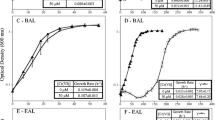Intact cells of Desulfovibrio desulfuricans, immobilized in polyacrylamide gel, removed Cr, Mo, Se and U from solution by enzymatic-mediated reduction reactions. Lactate or H2 served as the electron donor and the oxidized Cr(VI), Mo(VI), Se(VI) and U(VI) served as electron acceptors. Reduction of the oxidized metal species resulted in the precipitation of solid phases of the metals. Metal removal efficiencies of 86–96% were achieved for initial concentrations of 1 mM Mo, Se, and U and 0.5 mM Cr. Insoluble metal phases accumulated on both the surface and the interior of the polyacrylamide gel. In column tests conducted for U removal, effluent concentrations less than 20 μg L−1 were achieved with initial concentrations of 5 mg L−1 and 20 mg L−1 U and residence times from 25–37 h. The enzymatic reduction of Cr, Mo, Se, and U by immobilized cells of D. desulfuricans may be a practical method for removing these metals from solution in a biological reactor.
Similar content being viewed by others
Author information
Authors and Affiliations
Additional information
Received 10 January 1997/ Accepted in revised form 19 September 1997
Rights and permissions
About this article
Cite this article
Tucker, M., Barton, L. & Thomson, B. Reduction of Cr, Mo, Se and U by Desulfovibrio desulfuricans immobilized in polyacrylamide gels . J Ind Microbiol Biotech 20, 13–19 (1998). https://doi.org/10.1038/sj.jim.2900472
Issue Date:
DOI: https://doi.org/10.1038/sj.jim.2900472




